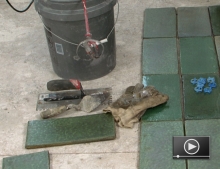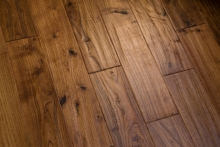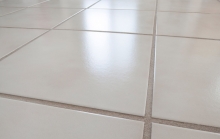How to Install Laminate Flooring
Video
Laminate flooring has become a very popular choice for do-it-yourselfers due to the fact that it’s economical, durable, and easy to install. Several varieties of laminate wood flooring are available, offering consumers a vast array of aesthetic choices. Most laminate flooring products share similar characteristics: a pressed wood base; a durable, adhered laminate finish; and a self-locking tongue and groove system. These systems typically do not require fasteners or adhesives – they just lock into place, basically “floating” above the subfloor. Join the At Home channel host, Jeff Wilson, for a tutorial on installing a laminate floor.
Area Prep
Before laying any of the laminate floor it is important to prep the work area and subfloor.
-
Remove furniture and appliances from the room.
-
Remove shoe molding and/or baseboard trim as necessary. You will need to install new or salvaged baseboard or shoe molding to cover the expansion gaps at the perimeter of the space to complete the floor installation. If baseboard is left in place, shoe molding can typically be installed to cover the expansion gap.
-
Remove existing flooring as necessary and check the subfloor. Most laminate flooring can be installed over a wide variety of subfloors and materials, so removal of existing flooring is generally limited to carpet or any loose or unsecured flooring. It's a matter of personal preference. Laminate flooring can typically be installed over concrete; any wood-, cement-, or gypsum-based underlayment board; old hardwood flooring; tile; vinyl; or in some cases even glued-down, low-pile carpet.
-
Prepare the subfloor as necessary. Sand any ridges in wood subfloors. Apply cement-based self-leveling underlayment over floors with excessive variations (more than 1/4”) in flatness.
-
Sweep the floor to remove any loose dust and debris.
Underlayment and Padding
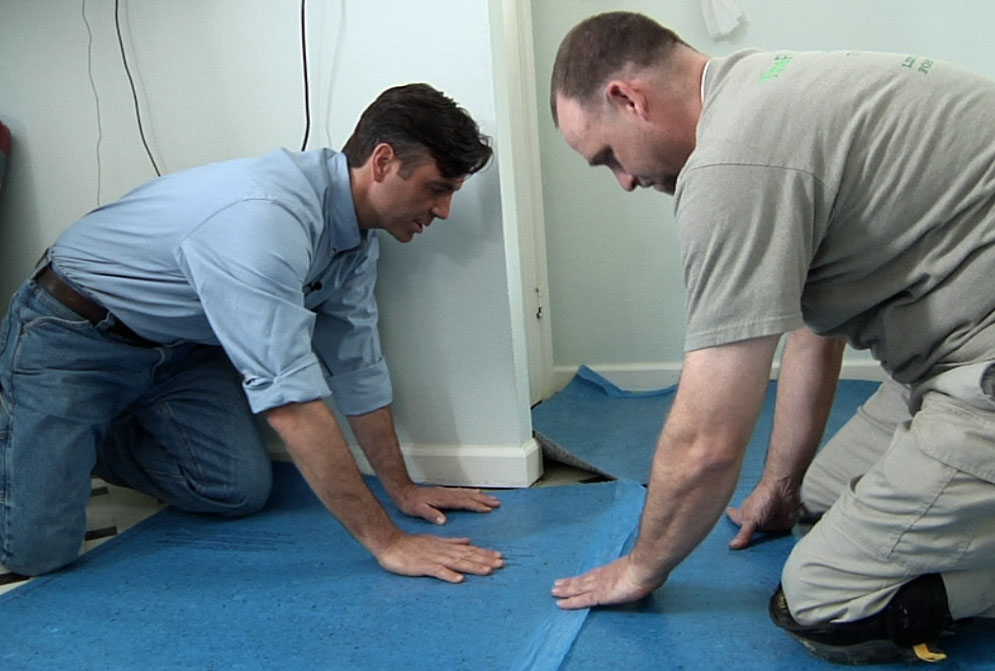
Once the work area and subfloor have been checked and prepped, the next step is to install any required padding and moisture barriers. Many laminates include an attached padding or underlayment, typically a thin, firm cushion applied to the underside of the board. Laminates with an attached underlayment pad typically require only the installation of a moisture barrier prior to installing the floor.
For laminates without an attached underlayment pad, several varieties of underlayment pad are available that provide a cushion, a thermal barrier, some sound absorption, and a built-in moisture barrier.
-
Roll out the moisture barrier, or padded underlayment, along the starting wall and cut to length. Place additional sections as necessary with taped butt seams.
Planning the Layout
Before installing any pieces of the laminate flooring, it is important to consider the layout of the floor. Generally it is best to run the laminate flooring parallel to the longest wall in the room. However, if you are installing laminate over an existing hardwood floor, it should be installed perpendicular to the existing planks.
-
Use a tape measure to check the room dimensions and compare with the dimensions of the laminate flooring boards.
-
Divide the width of the room by the width of the laminate boards to determine the width of the final row. If the final row will be less than 2”, you may want to consider trimming an inch or two off the width of the first row.
-
Divide the length of the room by the length of the laminate boards to determine how long the piece will be at the finishing wall. If this piece is less than 3”, trim 3”–6” off the starting piece.
Installing the First and Second Row
With the layout determined, it is time to start laying the laminate floor.
-
Open three or four boxes and select boards from each box to minimize repeating patterns in the floor.
-
It is typically best to begin on the left side of the room and work toward the right.
-
Use 1/4” spacers and set the first full board in the corner with the tongue facing the wall. Check the manufacturer’s instructions for proper orientation of the boards to facilitate the locking method.
-
Continue to install the first row by aligning the short ends and locking them together. Lift the board at a 45° angle and align the tongue and groove. Push and lower the board to lock the boards together.
-
For the last piece in the row, measure the distance to the wall, subtract 1/4”, and cut the board accordingly. Use a pry bar or tapping block as necessary to lock the joint together.
-
Start the second and subsequent rows with the leftover piece from the last board in the previous row. If the leftover piece is too small, cut a piece to fit, maintaining a minimum 8” stagger between butt ends.
-
Continue using 1/4” spacers at the beginning and end of each row.
-
Laminate floor boards are typically all the same length, but they must still be installed like hardwood flooring, with staggered butt joints across the floor. For a staggered, random look, pay attention to keep the joints from lining up or creating a repeating pattern across the whole floor.
-
Use a string line, level, and framing square as necessary to keep the rows straight and square to ensure a good foundation for the rest of the floor.
Installing the Remaining Rows
Once the first few rows are set, the rest of the flooring is pretty easy to snap together.
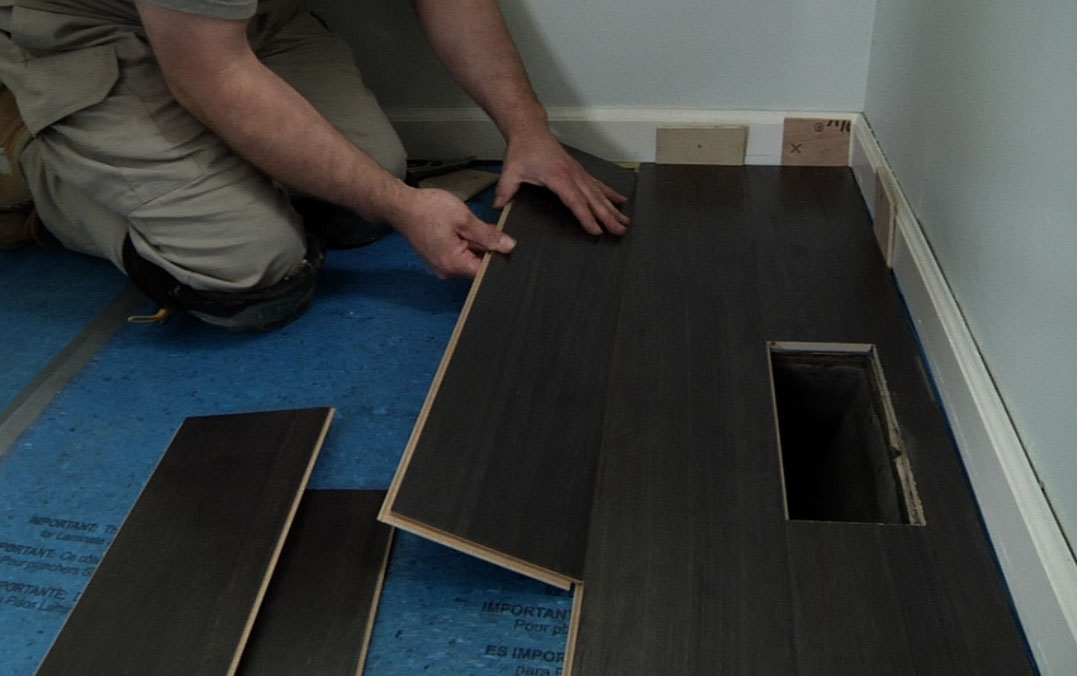
-
Continue to install the floor boards one row at a time, using a 1/4” spacer to begin each row and staggering the end joints 8” minimum.
-
Align the long end of the boards and insert the tongue into the groove at an angle. Position the short end over the groove of the previous board and press flat to the floor to lock the long ends of the boards together.
-
Use a pry bar or tapping block to ensure that the joints are tight. Always use a block with your hammer to distribute the force of the tapping – using a hammer alone can damage the flooring.
Cutting Laminate Flooring
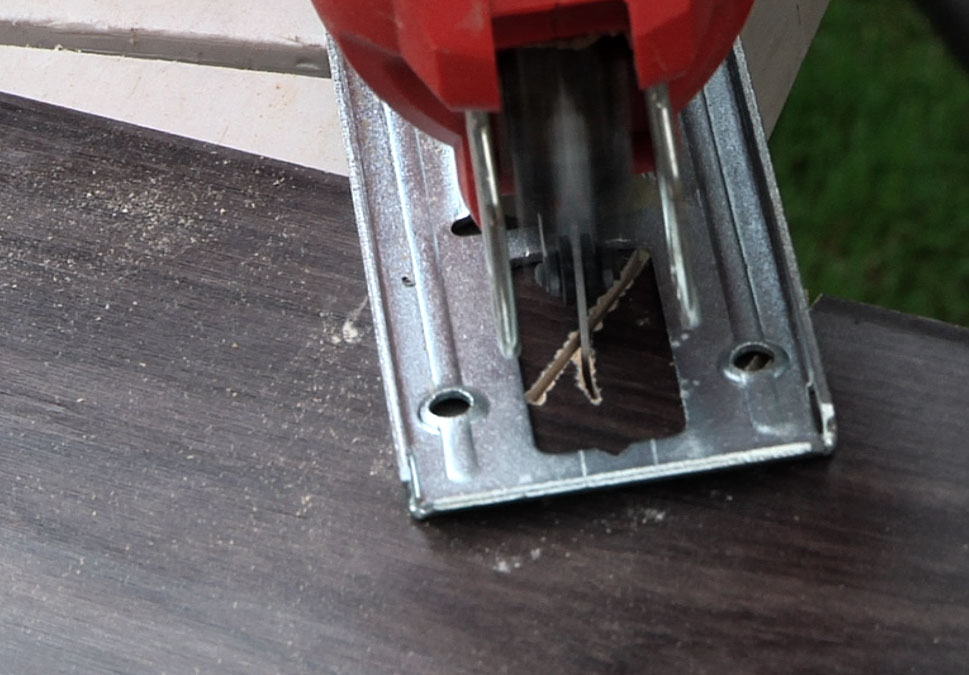
Laminate flooring can be cut by using any saw and high-quality carbide-tipped blade that can be used to cut wood. A power miter saw, or chop saw, is a useful saw for square cuts along the length of the board. A jigsaw is handy for cutting out holes and notches to fit around piping and corners.
-
To minimize chipping, cut the board with the finished surface up.
-
Use masking or painter’s tape along the cut to minimize chipping the finished surface.
-
Cut in a separate area to minimize sawdust in the work area.
Doorways and Transitions
Every laminate floor installation will have at least one or two doorways or floor transitions to finish. Some installations may include a stair edge to finish as well. These areas require extra attention and a little patience to achieve quality finish details.
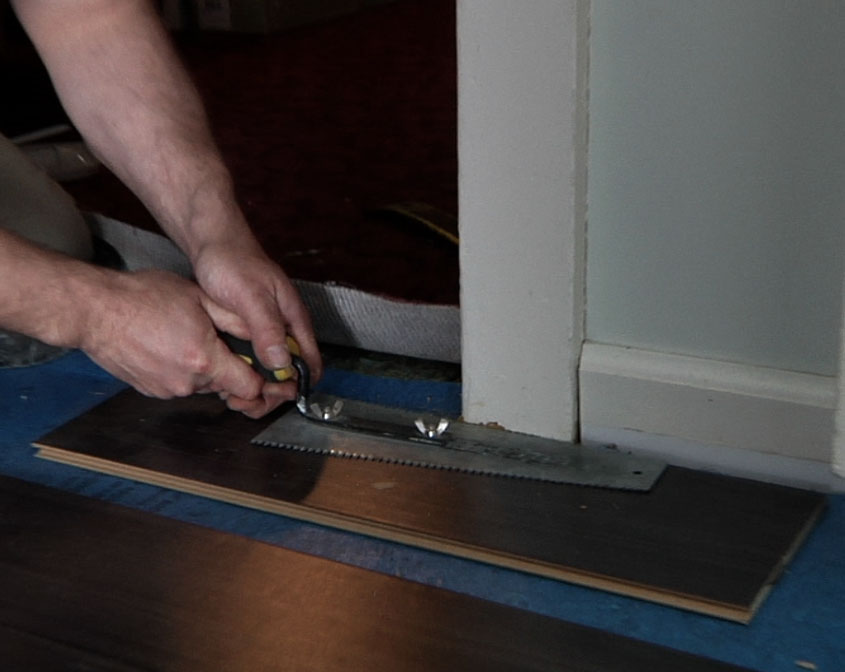
Whether the finished floor stops in the doorway or continues through into another space, it is often necessary to trim the doorjambs first. As shoe molding cannot be installed against the doorjamb, the finished floor must fit under the jamb and any casing to hide the expansion gap.
-
Using a scrap piece of flooring as a guide, cut the doorjamb with a jamb saw or flush-cut saw. Use a wood chisel as necessary to cleanly remove the cut-off piece of doorjamb and casing.
Once the flooring can be laid under the doorjambs and casing, the transition strips can be installed. The transition strips hide the edge of the laminate flooring as well as the adjacent flooring and cover the necessary expansion gap. Most transition strips come with a track and can be configured in multiple ways.
-
Fasten any transition strips and tracks to the subfloor, not the laminate floor, maintaining the 1/4” expansion gap.
-
Measure the opening and cut the track to fit.
-
Screw the track into the subfloor.


Measure the opening for the finish transition strip and cut to fit. Miter or cope the ends as necessary to fit snugly against the adjacent trim or frame.
-
Snap the transition strip into the track.
To finish a laminate floor edge at the top of a staircase, many types of stair nosing are available.
-
Measure and cut the stair nosing to fit.
-
Using the stair nosing as a guide, determine the final edge of the laminate flooring. Maintain a 1/4” gap against the stair nosing.
-
Install any remaining laminate flooring up to the stair edge.
-
Apply construction adhesive to the bottom of the stair nosing and set it in place at the stair edge. Be sure to cover the laminate floor edge and 1/4” expansion gap.
-
Install finish nails as necessary with a hammer and nail set or pneumatic finish nail gun.
Finishing Touches
The final step in completing a laminate floor installation is to cover the expansion gaps around the perimeter of the room. This can be accomplished by installing new or salvaged baseboard, or by installing a quarter round, or shoe, molding against existing baseboard. Always install baseboards or moldings to the wall and not to the laminate floor, to preserve the floating effect of the floor system.

Ryan Carpico
Ryan is a Registered Architect who earned a Bachelor of Architecture from the University of Kentucky in 1998. His experience in a broad spectrum of architectural projects includes design and project management in multi-family residential, general commercial, and institutional projects. This architectural experience is balanced with a background in general contracting of residential and light commercial construction projects. Ryan’s knowledge and ability as both architect and builder enable him to address both the technical and practical sides of the comprehensive body of construction knowledge.
Website: carpicodesign.com/
